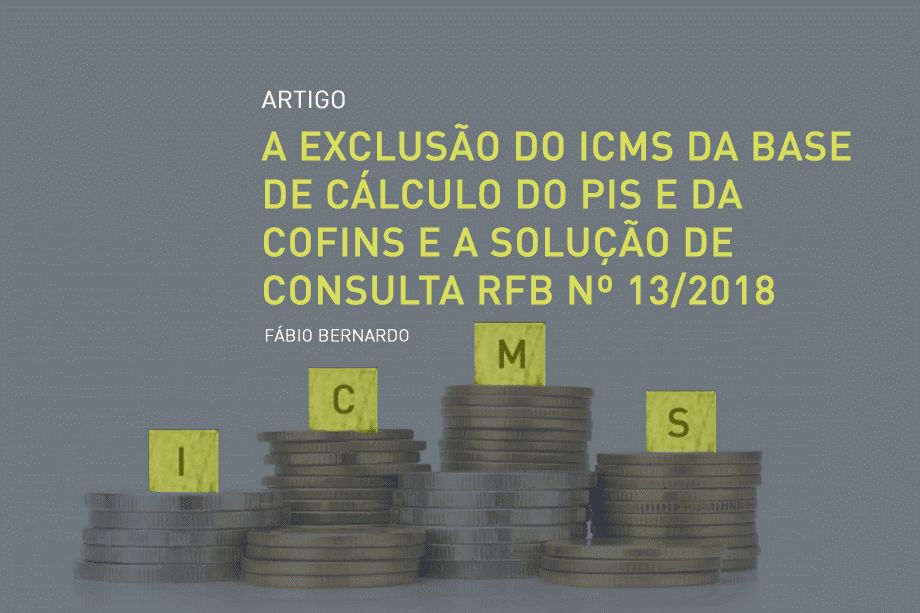Fábio Bernardo
Lawyer at Marcos Martins Advogados
After two decades of discussion, the Federal Supreme Court, at the conclusion of Extraordinary Appeal No. 574.706/PR¹, ruled that ICMS should not be included in the PIS and COFINS tax base.
As a result of this judgment, several taxpayers have obtained injunctions to exclude the state tax from the basis for calculating federal contributions, thus reducing their tax burden.
On October 23, 2018, the Federal Revenue Service published COSIT Internal Consultation Solution No. 13/2018, which deals with the matter and applies to taxpayers who have a final and unappealable court decision authorizing the exclusion.
According to the IRS’s understanding, the amount to be excluded from the basis for calculating the contributions is not the ICMS highlighted on the invoices, but only the ICMS to be paid at the end of the assessment period.
It was surprising that the Federal Revenue Service issued this Consultation Solution, given that this issue was the subject of a Motion for Declaratory Ruling by the PGFN in the Supreme Court judgment, which is still pending analysis.
If the Federal Government, through the PGFN, demonstrates that it has doubts about the interpretation of the STF ruling regarding the ICMS that should be excluded from the PIS and COFINS tax base, so much so that it has filed declaratory embargoes, how could the Federal Revenue Service, a body also linked to the Federal Government, be certain about the matter and state categorically, interpreting the ruling of the Constitutional Court, that the ICMS to be excluded is the one that the taxpayer actually has to pay?
In practice, this drastically reduces or even nullifies the possibility of tax savings with the exclusion, since the ICMS to be paid, as a rule, is not the one highlighted on the invoice.
In some cases, the taxpayer may not even pay ICMS at the end of the calculation, due to accumulated credits from export operations, for example, which would make it impossible to exclude any amount from the PIS and COFINS calculation basis.
In this context, the purpose of this brief article is to discuss the implications of this consultation solution and whether there is a legal basis to support the understanding set out in it.
Initially, it should be mentioned that the STF’s ruling is not clear and express as to the amount of ICMS that should be excluded from the PIS and COFINS calculation basis, there are passages in which the Justices state that “all the tax” should not be part of the calculation basis, and others in which they speak of “ICMS paid”.
The Federal Revenue Office, when analyzing the ruling, obviously only looked at the passages in which it is possible to construct an interpretation to the effect that the tax to be excluded is that due at the end of the assessment period.
However, from a legal point of view, it makes no sense to say that the ICMS to be excluded from the basis for calculating federal contributions is the one actually due, after the taxpayer’s debits and credits have been reconciled.
According to article 13 of Complementary Law 87/96, the ICMS calculation basis is the total value of the transaction, which corresponds to the taxpayer’s turnover. The tax is levied on the total value of the output.
As it is a tax calculated from the inside, the total amount of ICMS highlighted on the invoices is included in the cash receipts resulting from the taxpayer’s outgoing operations.
The ICMS that has always formed the basis for calculating PIS and COFINS, therefore, is the ICMS highlighted on the invoice, calculated from the inside and passed on to the end consumer. If the ICMS that forms part of the basis for calculating federal contributions is the one highlighted on the invoice, it is this ICMS that should be excluded.
The ICMS actually due under the non-cumulative system has nothing to do with the calculation basis for PIS and COFINS, so when it stated that ICMS does not form part of the calculation basis for these contributions, the Federal Supreme Court was obviously referring to the ICMS highlighted, because you can’t exclude something that isn’t included.
If the Supreme Court had wanted to limit the scope of its decision, it would have done so expressly, and the ruling makes it clear that the Court considered in its considerations the non-cumulative system for calculating ICMS.
The understanding expressed in the Federal Revenue Service’s Consultation Solution causes a complete distortion in the tax system.
Imagine the situation of a taxpayer who has several ICMS credits disallowed by the state tax authorities in a given assessment period. This disallowance of credits means that the ICMS due on exit is higher than that initially calculated.
In this situation, how would the tax be excluded from the PIS and COFINS calculation basis? Should the portion of the credits disallowed automatically be excluded from the basis for calculating federal contributions? What if the state tax demand is annulled in an administrative or judicial trial? How would the limitation and decay periods be?
It is clear that the calculation of federal contributions cannot take into account the ICMS non-cumulative system, but rather the tax that was actually deducted and charged to the next party in the chain.
There is even a judgment subsequent to the leading case in which Justice Gilmar Mendes, who by the way voted against the thesis of excluding ICMS from the PIS and COFINS calculation basis, expressly states that the STF would have established the understanding that it is the tax highlighted on the invoices that should be excluded from the calculation basis of the contributions due to the Union.
This is Extraordinary Appeal 954.262², judged on August 22, 2018, which dealt with a case involving the exclusion of ICMS from the calculation basis of the Social Security Contribution on Gross Revenue – CPRB, the most important excerpt of which we transcribe below:
The appeal is well-founded. Initially, I note that a similar matter was decided in RE-RG 574.706, (theme 69), Reporting Justice Cármen Lúcia, DJe 2.10.2017. On that occasion, the Federal Supreme Court stated that the amount of ICMS highlighted on invoices does not constitute revenue or billing, which is why it cannot be part of the PIS and COFINS calculation basis. (emphasis added)
The Consultation Solution in question is a ludicrous attempt by the tax authorities to slap taxpayers on the wrist after losing a billion-dollar dispute in the Federal Supreme Court.
Bearing in mind that the majority of court decisions do not expressly state whether the ICMS to be excluded is the ICMS highlighted on the invoices or the ICMS due at the end of the assessment, there is a huge risk that taxpayers who have been excluding all the tax highlighted will be assessed.
In this context, it is hoped that the Supreme Court will swiftly rule on the Federal Government’s Motion for Declaratory Ruling, so that this issue can be put to an end, avoiding another long year of administrative and judicial discussion.
___
¹ BRAZIL. Supreme Federal Court, Extraordinary Appeal No. 574.706/PR, Rel. Min. Carmem Lúcia, DJe-223, Brasília, 29.09.2017. Available at: . Accessed on: December 8, 2018.
² BRASIL. Supremo Tribunal Federal, Extraordinary Appeal No. 954.262/RS, Rel. Min. Gilmar Mendes, DJE No. 173, released on August 22, 2018. Available at: . Accessed on: December 8, 2018.








